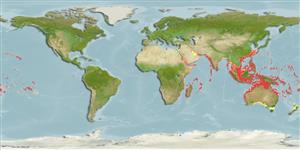>
Aulopiformes (Grinners) >
Synodontidae (Lizardfishes) > Synodontinae
Etymology: Synodus: Greek, syn, symphysis = grown together + Greek, odous = teeth (Ref. 45335).
More on author: Lacepède.
Environment: milieu / climate zone / depth range / distribution range
Écologie
marin récifal; profondeur 0 - 121 m (Ref. 58302), usually 5 - 60 m (Ref. 37816). Tropical; 30°N - 45°S
Indo-Pacific: Red Sea and East Africa to the Hawaiian, Line, Marquesan, and Ducie islands, north to the Ryukyu Islands, south to the Lord Howe, Kermadec and Rapa islands (Ref. 1602). Reported from New Zealand (Ref. 5755) and Persian Gulf (Ref. 68964).
Length at first maturity / Taille / Poids / Âge
Maturity: Lm 14.0 range ? - ? cm
Max length : 40.0 cm TL mâle / non sexé; (Ref. 637); common length : 30.0 cm TL mâle / non sexé; (Ref. 637)
Épines dorsales (Total): 0; Rayons mous dorsaux (Total): 10-14; Épines anales 0; Rayons mous anaux: 8 - 10. Adults variable from grey to red (Ref. 48635). On some individuals, the hourglass- or saddle-shaped markings along its side may be obliterated by an almost solid dark red band (Ref. 1602). Large individuals are often thick-bodied, giving a hump-backed appearance (Ref. 1602).
Inhabits deep lagoon and seaward reefs to depths over 40 m (Ref. 9710); sometimes found on sandy bottoms concealing itself in the sand. Prefers to rest on hard surfaces and frequently occurs in pairs (Ref. 37816). Benthic (Ref. 58302). Feeds on small fishes by seizing these from passing schools, also shrimps (Ref. 89972). Caught with various types of artisanal gear; sold fresh or dried salted in markets. Minimum depth reported taken from Ref. 128797.
Life cycle and mating behavior
Maturité | Reproduction | Frai | Œufs | Fécondité | Larves
Randall, J.E., G.R. Allen and R.C. Steene, 1990. Fishes of the Great Barrier Reef and Coral Sea. University of Hawaii Press, Honolulu, Hawaii. 506 p. (Ref. 2334)
Statut dans la liste rouge de l'IUCN (Ref. 130435)
Menace pour l'homme
Harmless
Utilisations par l'homme
Pêcheries: commercial
Plus d'informations
RéférencesAquacultureProfil d'aquacultureSouchesGénétiqueElectrophoresesHéritabilitéPathologiesTraitementNutrientsMass conversion
Outils
Articles particuliers
Télécharger en XML
Sources Internet
Estimates based on models
Preferred temperature (Ref.
123201): 24.2 - 29, mean 27.8 °C (based on 2250 cells).
Phylogenetic diversity index (Ref.
82804): PD
50 = 0.5000 [Uniqueness, from 0.5 = low to 2.0 = high].
Bayesian length-weight: a=0.00513 (0.00404 - 0.00652), b=3.19 (3.14 - 3.24), in cm total length, based on LWR estimates for this species (Ref.
93245).
Niveau trophique (Ref.
69278): 4.2 ±0.5 se; based on diet studies.
Generation time: 2.6 ( na - na) years. Estimated as median ln(3)/K based on 1
growth studies.
Résilience (Ref.
120179): Haut, temps minimum de doublement de population inférieur à 15 mois (K=0.4).
Fishing Vulnerability (Ref.
59153): Low to moderate vulnerability (30 of 100).
Nutrients (Ref.
124155): Calcium = 43.2 [15.8, 86.0] mg/100g; Iron = 0.48 [0.17, 1.06] mg/100g; Protein = 15.9 [12.9, 18.2] %; Omega3 = 0.0636 [, ] g/100g; Selenium = 39 [16, 87] μg/100g; VitaminA = 96.6 [24.3, 306.4] μg/100g; Zinc = 0.866 [0.501, 1.302] mg/100g (wet weight);
